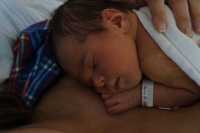
26 Mar Kangaroo Care Linked to Better Infant Brain Development
MedicalResearch.com Interview with:
Jillian Hardin, Ph.D.
Developmental Psychophysiology Lab
Florida Atlantic University
MedicalResearch.com: What is the background for this study?
Response: Most Kangaroo Care (KC) research examines the procedure’s positive physiological and psychological developmental effects on preterm infants as these infants are separated from their mothers before the end of gestation. However, the aim of our study was to determine whether kangaroo care parent-training and implementation with non-vulnerable, full-term infants provided developmental neurophysiological benefits.
 MedicalResearch.com: What are the main findings?
MedicalResearch.com: What are the main findings?
Response: Although the sample size was small, the results of the study suggested that both neuroendocrine and cortical benefits were uncovered. Extended kangaroo care use was associated with increased maternal and infant oxytocin, a hormone associated with relaxation and mammalian relationship formation/attachment as well as decreased infant cortisol, a stress hormone.Importantly infants exposed to KC also demonstrated EEG patterns associated with enhanced neurodevelopmental patterns, including increases in left frontal asymmetry and EEG coherence patterns that reflect more distant connections between brain regions.
MedicalResearch.com: What should readers take away from your report?
Response: Our study suggests there may be neurodevelopmental benefits associated with extended kangaroo care use in healthy, full-term infants.
MedicalResearch.com: What recommendations do you have for future research as a result of this work?
Response: One goal that we have for future research is to examine kangaroo care’s impact on relationship patterns of mothers and infants exposed to mood disorders. In particular, infants of depressed mothers have EEG patterns and emotionally interactive behaviors that have been shown to be dysregulated. Modifying the experiences by resetting the trajectory of these dyads may attenuate risk. Our goal is to suggest naturalistic and simple interventions that can positively impact these dyads.
In addition, research on infant urinary and salivary oxytocin needs to be validated, to determine if the current results are replicable, as our sample size was small and salivary oxytocin pattern could be more expeditious to interpret and potentially intervene when necessary.
MedicalResearch.com: Is there anything else you would like to add?
Response: While we recognize that social distancing now is the norm for these risky times (with COVID-19), mothers and babies who are not affected by the disease still need contact and touch to thrive and for relationship formation. Individual circumstances may lead to isolation or separation and we trust the medical community to make appropriate recommendations for each unique mother-infant dyad.
No other disclosures as we do not sell/advertise for any specific products related to this study.
Citation:
Jillian S. Hardin, Nancy Aaron Jones, Krystal D. Mize, Melannie Platt. Parent-Training with Kangaroo Care Impacts Infant Neurophysiological Development & Mother-Infant Neuroendocrine Activity. Infant Behavior and Development, 2020; 58: 101416 DOI: 10.1016/j.infbeh.2019.101416
[subscribe]
[last-modified]
The information on MedicalResearch.com is provided for educational purposes only, and is in no way intended to diagnose, cure, or treat any medical or other condition. Always seek the advice of your physician or other qualified health and ask your doctor any questions you may have regarding a medical condition. In addition to all other limitations and disclaimers in this agreement, service provider and its third party providers disclaim any liability or loss in connection with the content provided on this website.
Last Updated on March 26, 2020 by Marie Benz MD FAAD

